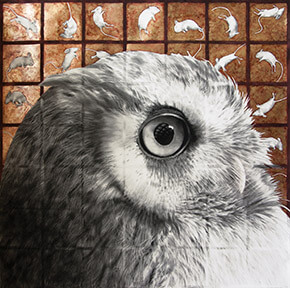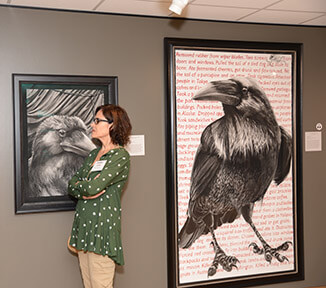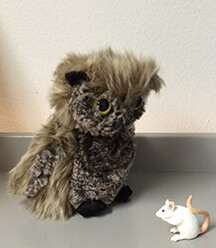Hundreds of metrics and tools exist to measure job performance, satisfaction, and efficacy. I knew I’d successfully accomplished a significant portion of my job – on a particularly program-packed day – when 3-year-old Thomas educated older sibling Ila about the mouse in the glint of Hubie’s eye. Thomas and his mom had attended Art Time for Tots earlier in the day, and he  delightedly shared the morning’s gallery stories with his older sister as she gathered for Art Kids in the evening.
delightedly shared the morning’s gallery stories with his older sister as she gathered for Art Kids in the evening.
More on Hubie in a bit.
I love my job, and the responsibility I most embrace is time spent in the gallery with any and all audiences – volunteer greeters during training for each exhibition, visitors, and program participants from young children to older adults. It’s a privilege. I often share art through stories. When recipients interpret, share, and craft their own new stories, I rate my day a success. In order to tell an informed, meaningful story, I try to learn about the process, medium, inspiration, subject, or history of the artworks on view. I then translate the information based on the audience. This is my challenge and what motivates me daily.
That recent day’s lineup of classes of children, from babies to 12-year-olds, began in the gallery dedicated to twelve works by Master Artist Karen Bondarchuk. The scale of the crows, ravens, and owls filling the gallery is daunting. A nearly five-foot-tall raven looms large in the room with an eight-foot ceiling. Also, a top-heavy four-foot-tall raven seems ready to topple out of the frame.
When listening to Karen describe her work in the audio-tour tracks or when reading the gallery labels, the vast, weighty references – pithy, thoughtful, and poignant inspiration for her work – seem as though they could burst ceilings of the gallery and topple the raven. Karen references the poetry of W.B. Yeats, the work of Old Master Hans Holbein, the cherub in Botticelli’s Primavera, Buddhist philosophy, and Japanese kakejiku scrolls. And to truly pluck the heartstrings à la the aforementioned cherub, much of her latest work (including the massive Ergo Sum) is, in Karen’s words, “. . . simultaneously a marker of my mother’s lost time [to Alzheimer’s disease] and a constant and acute reminder of my own days, my life, and an attempt to signal visually the preciousness and individuality of each day.”
The aforementioned Hubie is an imprinted owl and a beloved subject in Karen’s work. This particular work is the captivating and evocative piece, Continuum, whose story is the parallel message of a captive owl and a journey into the confines of Alzheimer’s disease. Devoid of the hunting skills necessary for self-sufficiency, Hubie is fed a mouse a day by his human caretakers at an avian rehabilitation and educational center. Karen imagines that Hubie organizes time around that daily mouse and his anticipation is reflected – literally – by a mouse in the glint of his eye.
I invite you to visit the Woodson Art Museum soon and often to discover art that grabs – or gently tugs – your attention. Take a closer look at an intriguing detail. Read a label and learn about the inspiration behind a work. Listen to artists describe their work on audio-tour tracks. Or simply “be” in the galleries with the art. Perhaps, like Thomas, you’ll be compelled to share the art and your discoveries with others – a true hallmark of the Museum’s “job well done.”
 PS: Translating Hubie’s story for our littlest visitors involves a dose of preparation, a scoop of imagination, and a dash of gallery magic . . . and an owl puppet, a plastic mouse, singing the days of the week set to the tune of “My Darling Clementine,” and the unbridled joy of children.
PS: Translating Hubie’s story for our littlest visitors involves a dose of preparation, a scoop of imagination, and a dash of gallery magic . . . and an owl puppet, a plastic mouse, singing the days of the week set to the tune of “My Darling Clementine,” and the unbridled joy of children.




